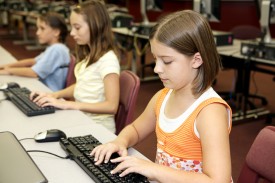
For many teachers, the words “flipped classroom” are nothing more than a synonym for having students watch pre-recorded lesson videos at home and then do related assignments – formerly homework – during class time. There’s no doubt that that is exactly what the flipped classroom typically looks like on the surface. But when flip teaching is done right, what matters is that it uses time differently and more effectively, in ways that can profoundly benefit all learners, including students with learning disabilities.
The flip teaching model:
Extends the learning day.
The ability to extend instructional time is a huge benefit for learners who grasp new concepts more slowly, or who aren’t able to process information as quickly as it’s presented. With flipped learning, they can rewind and re-watch a video as many times as needed until they understand the material – or perhaps until they understand what they don’t understand so they can get help in that area the next day.
Makes precious teacher time more available to students.
With instruction now happening at home on students’ time, teachers have more time to observe students as they apply what they have learned. As a result, teachers have more opportunities to watch students at work, so they can better identify student learning challenges and support struggling students with differentiated activities or targeted intervention.
Levels the playing field.
Flipped instruction puts students with learning disabilities on more equal footing for effective classroom participation. Learners who formerly may not have immediately grasped their teacher’s in-class instruction may now feel empowered to contribute to classroom discussions and ask informed questions instead of worrying about “looking dumb.”
The Naysayers and Their Challengers
Critics of the flipped classroom approach to blended learning say that access to videos can be a problem, especially in communities with a large number of learners from low-income households. Students may not have a computer or internet connection at home, may have to share already-limited computer time with other family members, or simply may not have time at home to watch lessons for the next day. The concerns are valid, but one visionary school is demonstrating that they can be overcome.
Clintondale High School, just outside of Detroit, is the first U.S. high school to move to a flipped model of learning school-wide. With a large population of economically disadvantaged learners, the school dealt with access concerns head-on by making extra time available in computer labs during the school day for learners who need it. One student who has limited time at home because of a long bus commute watches most of his lesson videos on a smartphone as he rides home from school. In just a few years, standardized test scores have gone up and the school’s failure rate has dropped dramatically from 52% to 19%.
Clintondale’s teachers note that the process is not as simple as just rearranging where and when direct instruction takes place; it’s essential that teachers get on board with mastering the technology and creating great lessons and learning activities. That way, students can get the most from every moment they spend learning and teachers can get maximum results for the time they spend creating content and supporting learners in the classroom.
Where Gen Ed & Special Ed Meet
A big boon for schools that move to flip teaching is that general ed technology can do double time as assistive technology for special ed. It’s a benefit for everyone, helping to reduce technology expenditures, the cost of managing technology, and the time that teachers spend adapting to learners’ assistive devices.
Still, flipped classroom veterans warn that setting high behavior standards for students is a must. Students need to know how they are expected to use their time at home and at school, and what specific behaviors will enable them to achieve their learning goals. Some students with learning disabilities may need additional help allocating their time and using it effectively. But when teachers, students, and parents are all on board, flipping has the potential not only to move more students to proficiency, but also to take more students beyond proficiency to the desired goal of mastery.
References:
Can Special Education Students Benefit From Flipped Classrooms?
Pros and Cons of The Flipped Classroom
For Further Reading:
How to create a ‘flipped’ video lecture for at-home study
Related reading:
The Flipped Classroom: A Pedagogy for Differentiating Instruction and Teaching Essential Skills
What New Brain Wave Research Tells Us About Language-Based Learning Disabilities

